
(1)
Ulica obozowa przed barakiem przeznaczonym dla księży. Camp street in front of the barracks for the priests (picture from the guidebook). Campamento enfrente de las barracas para curas.
| 
(2)
Pomnik przed muzeum (widok od tyłu). Memorial monument in the center of the yard in front of the museum (view from the back). Monumento conmemorativo enfrente del museo en el centro del campo (Visto por detrás).
|
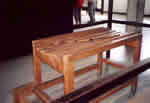
(3)
Stół karny. Więzień był zmuszany do kładzenia się na stole, a strażnik zadawał 25 uderzeń kijem (widocznym na stole). Jeśli więzień wydal jakiś jęk, strażnik zaczynał liczyć od początku. W związku z tym zazwyczaj zadawano o wiele więcej, czasem nawet kilkaset uderzeń. Punishment table. The prisoner was lying on the table and the guard administered 25 lashes with a stick (shown on the table). But the guard was supposed to start the count again, if the prisoner screamed. So, actually there were usually more than 25 lashes, sometimes hundreds. Mesa de castigo. El prisionero se recostaba en la mesa y el guardia le pegaba 25 azotes con el palo que está sobre la mesa. Pero el guardia empezaba a contar desde cero otra vez si el prisionero gritaba o se quejaba. Entonces eran más de 25 azotazos, a veces cientos.
| 
(4)
Inny pomnik na placu przed muzeum. Another monument in the yard, near the first one. "Never again". Monumento en el campo, cerca del primero.
|
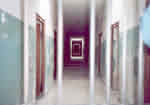
(5)
Barak z celami. Pomieszczenia dla księży, w innej części obozu, były bardzo podobne. A barrack with cells. The priests' cells were exactly like this one, but in a different location. Barraca con celdas. En la otra dirección, pero exactamente iguales a estas, se encuentran las celdas de los curas.
|
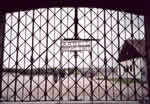
(6) | 
(7)
Ja (Barbara) przy bramie wyjściowej. That's me (Barbara) in the same gate. Esta soy yo en la misma puerta.
|
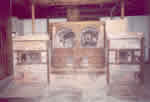
(8)
| 
(9)
Duże krematorium - z trzema paleniskami. Więźniowie którzy tam pracowali, musieli spać na miejscu, żeby nie było możliwości powiadomienia innych o wydarzeniach w krematorium. Czasem ilość ciął wzrastała do kilkuset i istniała konieczność palenia jednocześnie więcej niz. jednego ciała, wówczas musieli oni łamać kości zmarłych, żeby ciała mieściły się do pieca. The big crematorium. There were 3 ovens. People that used to work there were prisoners themselves. They had to sleep there, so they couldn't tell other prisoners what was going on. Sometimes there were hundreds of dead bodies, so they had to incinerate more than one body at the same time; they had to smash the bodies to break the bones, so they could put a couple of bodies in a pile to incinerate them together. Crematorio grande. Ahí hay tres hornos. La gente que solía trabajar ahí eran los mismos prisioneros. Ellos debían dormir ahí para no poder contarles a los otros prisioneros lo que sucedía en ese lugar. A veces había cientos de cuerpos y debían cremar más de uno a la vez, entonces los golpeaban para romper los huesos y poder apilarlos para quemarlos juntos.
|
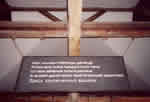
(10)
| 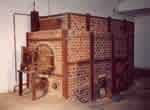
(11)
|

(12)
| 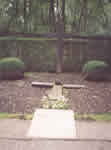
(13)
|
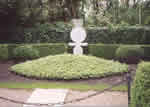
(14)
| 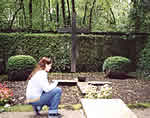
(15)
|
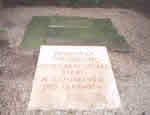
(16)
| 
(17)
|
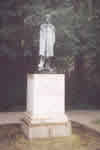
(18)
Pomnik przy drodze prowadzącej do krematoriów przedstawiający odwagę i nieugięty opór w postawie więźnia - głowa podniesiona wysoko, ręce w kieszeniach i jedna stopa wysunięta przed druga.... Tego rodzaju postawa mogła dostatecznie sprowokować strażnika i spowodować jego decyzje, żeby zabić więźnia. Napis wyryty na cokole: "DEN TOTEN ZUR EHR. DEN LEBENDEN ZU MAHNUNG". (Ku czci zmarłych. Dla przestrogi żyjącym). This monument stands along the way to the crematoriums and it represents the very brave attitude of a prisoner. The chin high, the hands inside the pockets and one foot in front of the other...This kind of attitude could provoke a guard so much that he would decide to kill the prisoner. The inscription says: DEN TOTEN ZUR EHR. DEN LEBENDEN ZUR MAHNUNG. It means: "To honor the dead. As a reminder to the living". Este monumento está antes del camino a los crematorios y representa una muy valiente actitud para un prisionero. La barbilla alta, las manos dentro de los bolsillos y un pie delante del otro. ..Este tipo de actitud podía provocar tanto a un guardia como para decidir matar al prisionero. Tiene gravado: DEN TOTEN ZUR EHR. DEN LEBENDEN ZUR MAHNUNG. Significa: "Por el honor de los muertos como un recordatorio a los vivos".
| 
(19)
Kaplica Ewangelicka. (Nie wiedziałam, ze to Kaplica Ewangelicka, weszłam, zapaliłam świece na ołtarzu i wpisałam w Księdze Odwiedzających w Kaplicy moje nazwisko i powód moich odwiedzin. To było trudne do uwierzenia - ilość jeżyków w jakich były dokonane wpisy w tej Księdze przez ludzi z wszystkich krańców świata, którzy się modlili o to samo: "Nigdy więcej"). Evangelical (Protestant) Chapel. (I didn't know that it was an Evangelical one, so I got into it and I lit a candle over the altar and I wrote in a visitors book in the Chapel my name and why I was there. It was amazing how many languages I found in that book, from people all around the world praying for the same reason: "Never again"). Capilla evangelista. No sabía que era una capilla evangelista, entonces entré y encendí una vela (sobre el altar) y escribí mi nombre y por qué estaba ahí en un libro de visitas dentro de la misma. Fue asombroso cuántos idiomas encontré en ese libro, de gente de todo el mundo rezando por la misma razón: Nunca más.
|
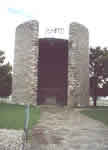
(20)
Kaplica Katolicka. Catholic Chapel. Capilla católica.
|
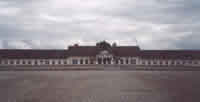
(21)
Muzeum Obozu. Przed Muzeum Pomnik Pamięci. The front of the museum, with the memorial monument in front. El frente del museo, con el monumento recordatorio.
|

(22)
Przed pomnikiem, w rękach trzymam dokumenty obozowe dotyczące Ks. Karola. Detail of the memorial monumet. I'm holding Karol's records. Detalle del monumento. Estoy sosteniendo los registros de Karol.
| 
(23)
| 
(24)
|
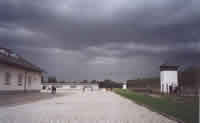
(25)
Widok w stronę wejścia dla odwiedzających. (Opuszczałam już obóz, odwróciłam się, ostatnie spojrzenie. Niebo zapadało się nade mną....). Visitors' entrance to the camp. I was leaving the camp and I turned around for the last view. The sky was close to falling down... La entrada al campo para los visitantes. Estaba dejando el campo y me di vuelta para una última mirada. El cielo estaba a punto de caer...
|
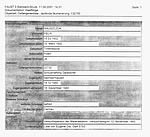
Feliks Wajszczuk | 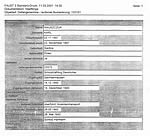
Karol Wajszczuk |

